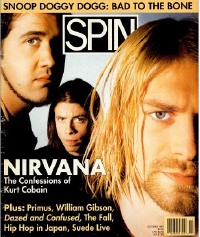 The earliest appearance of the word--which probably didn't cross my mind ten times in the 1980s and 90s--was in February 1986. The last was September 2005.
The earliest appearance of the word--which probably didn't cross my mind ten times in the 1980s and 90s--was in February 1986. The last was September 2005.
Of the ten, four involve poor women, including two mentions of black girls with a boombox and a walkman, respectively, on their strollers. Another is a crystal meth addict who turns tricks all night while her kid stays strapped in the stroller in the hall. The fourth is mentioned as color for a Northern Irish street corner scene.
One mention is a vintage clothing piece, where the writer says she looks like her mom in some old photo, pushing her kid [the writer] in a stroller. The other one, I can't remember. Whatever.
But four mentions involve dads, which seemed notably high to me. Here they are, in order of depressingness and/or proximity to Nirvana:
Jon Caramanica's story on Houston Hip-Hoppers [Sep. 2005]
"One guy, lacking a crate or a chair, sinks deep into a creaky baby stroller. Its previous occupant, a young girl with pigtails, snoozes in his lap."
Chuck Eddy's review of Everclear's So Much For The Afterglow [Nov. 1997]
"A decade ago, I pushed my toddler son's stroller through Ann Arbor, Michigan, where marijuana was almost legal, and even adults dressed like college students. Suspicious of parental guidance, proto-Grunge Kinko's slackers dished out enough uncomprehending stares to turn me against college radio smugness forever and recognize the nuclear-familiar virtues of the suburban Top 40 I'd long since abandoned. A guy my age (mid-30s), Art Alexakis shares a two-story house outside Portland with his wife and preschool-age daughter, and sounds as if a decade ago, he should have been reciting plain old melodic Tom Petty/ John Mellencamp parables. But now it's the 90s, so he dresses Lollapaloozoid and adds Nirvana power chords, even though the first and last songs on 1995's Sparkle and Fade analyzed life in Mellencamp's "small town.""Smashing their heads against the punk rock," Darcey Steinke's epic hanging out with Nirvana feature [Oct. 1993]
The painting from the cover of Incesticide leans against a wall, a giant telescope in front of it. On the floor, near a big cardboard box overflowing with papers, is a bound, black journal with a Polaroid of Frances glued to the front, sandy-haired and adorable. "The Bean," as Cobain sometimes calls her, has flown off with the nanny today to see her mother in England, where she's playing with Hole at the Phoenix Festival. There are reminders of both of them everywhere. Love's guitar, painted red with Victorian flowers; her 70's fake fur coat in the closet; Frances's playpen, her stroller, her dirty little baby socks all over the place.Bob Guccione Jr's "Life After Death," about the aftermath of ethnic cleansing in Sarajevo [Aug. 1996]
Captain Claridge, a British officer in the IFOR (NATO's Implementation Force) press office, told me this was the first war where civilians were the primary target. She told me about a man walking his three-year-old son in a stroller and a sniper shot the child in the head, rather than the father. Why? Because there was more horror, more residual terror, in killing a child in front of his parent.Search Spin Magazine on Google Books for "stroller" 1-10 of 10 results [google books]

